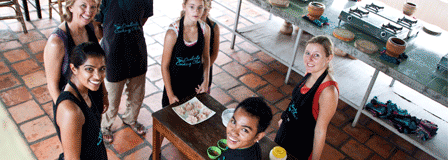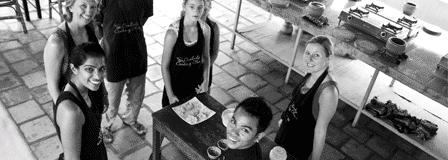Putting the Indo in Indochina
In Central and South America, I was mistaken for all of the following nationalities: Belizean, Nicaraguan, Panamanian, Dominican, Israeli (to be fair, the woman might’ve been high), Colombian, Peruvian, and Brazilian. One week in Cambodia and I am decidedly Indian – even the woman giving me my $5 mani/pedi yesterday pointed out my Indian nose. This is my first time in Indochina, and I’ve always wondered how people in this region feel about both their giant over-populated neighbors. India and China have an exceedingly long history of fighting over lands, people, power, and religion in those unfortunately located areas that happen to fall in between the two – there are still border disputes between them. So I wondered… how would an Indo in Indochina fare?
After less than a week, I can confidently say that Cambodians like Indians. We are seen as kindred spirits and neighbors – Indians introduced Hinduism, Buddhism, certain cultural norms, and a variety of spices to this region. Interestingly on the spice front (and we learned this in our Khmer cooking class discussed in-depth below), the Indian curry was first to the world, followed by the Khmer (Cambodian), and then the Thai. Take that, panang. The only “issue” with me is my tall white husband – interracial marriage is definitely less common in these areas of the world. Since I’m an “us” on this continent and I married a “them” – it’s clearly a little strange for some people.
Two other immediate observations, one much more superficial than the other, but still worth nothing:
1. Cambodians, despite their more-intense poverty, are much more attractive people (as a whole) than Central Americans, thus providing an important exception to the theory that money buys beauty.
2. I’m pretty sure these are the friendliest people on the planet. We’ve met some really helpful and nice people in many different places all over the world, but as an embedded culture of the people (thanks to Buddhism?), the Khmer win. And to have this intense kindness after going through some of the MOST ridiculous events mankind has ever seen – even towards the Americans who first bombed their country and then ignored their genocide while still recognizing their insane leader. THAT is taking the lessons of Buddha to heart.
A note on poverty because I think T&I will be writing about it frequently in the coming months. Every time we see a begging child, amputee, blind person etc. it is as heart-wrenching as it was the first time. Watching a child defecate in water that another child is drinking out of is the most horrendous crime against humanity I’ve ever personally witnessed, and I’ve seen it on multiple occasions. These are images that are so easily tossed around on TV informercials that you forget they’re REAL. Not just in Asia, of course, but that’s all I can speak to.
I have visited India frequently, and I think those visits have had their advantages and disadvantages when it comes to being able to handle certain sights. The obvious advantage is that I’ve seen the despair in a child’s eyes too many times before so at least I don’t cry every time I see it now (as a child, I did, and I was often reprimanded for giving all my money away to begging kids on the street – not because my family didn’t care, but because they knew what it was really going toward and I didn’t).
The disadvantage, in my mind, is that I’ve always seen someone worse off, and in some ways, it has hardened me. There are certain images that have haunted me since I was a kid, as I know they haunt many of my fellow ABCDs (American Born Confused Desis). When you’re 8 and going to visit your grandmother for your once every 3-4 years visit, and you are CONSTANTLY surrounded by children your age and younger who are dirty, starving, naked, sick, beaten, disabled… who look like you. It’s terrifying and confusing, and it’s not something you forget – ever. So when we were in Brazil or Panama or even in Seattle and a perfectly able adult on the street was begging… my sympathy was almost nonexistent because I just don’t think they have it THAT bad. Harsh, yes, but honest.
I cannot adopt them all (even though I want to- Cambodian kids are ridiculously adorable). I cannot pay for all of them to be put in shelters and schools and fair work environments and be given the chance to live a better life – a chance they deserve. I cannot even give them all $1 because I don’t have enough dollars for the numbers of deserving, and the money goes to their “pimp” 95% of the time anyway. I cannot bring their parents back or force their “slave-masters” to give them up or protect them from the assholes of the world. I cannot give them back their childhood that they have been robbed of.
But I can give them food or clean water when I see them. I can donate to (local) charities that are doing real work to improve the situation for some. I can seek out reputable tour companies and hostels/hotels and restaurants that give back to the community in some way, whether a massage parlor that trains blind masseuses or a restaurant that gives orphaned teenagers jobs in hospitality. I can volunteer with organizations and give them my time to help in some small way. And someday, I can at least adopt 1 child out of such a situation and give him/her the chance for something better. I have to keep telling myself these things, or I will break down and cry every single day I’m on this continent (except maybe in Singapore).
But I digress…
We landed in Phnom Penh on Tuesday morning and had a pretty heavy dose of jetlag until Friday. We didn’t see all of the sites in PP – no museums or the Royal Palace – but we did visit the utterly horrifying, gruesome, and somber Killing Fields at Choeung Ek. If you know nothing about the Khmer Rouge and genocide that took place in Cambodia in the 1970’s, I highly suggest educating yourself (great start at the Yale University Cambodian Genocide Project). The super brief summary is as follows. The Khmer Rouge led by Pol Pot was a communist dictatorship (essentially) whose most (in)famous impact was its attempt at social engineering – aka genocide – in an attempt to create the perfect agrarian community.
In 4 short years from 1975-1979, the regime managed to kill approx. 1.3M Cambodians in mass at a variety of killing fields around the country. Since bullets were expensive, most “prisoners” (including women, children, the elderly, the infirm, etc.) were beaten to death. Choeung Ek outside of PP is the most well-known (and accessible) of the fields, and mass graves containing approx. 8,800 people were discovered after the fall of the regime (with new remains being discovered frequently). Today, it is the site of a memorial with an audio-guided tour detailing what happened at the field and life under the horrors of the regime. The focal point of the memorial is a gigantic Buddhist stupa with glass sides filled with 5,000 skulls (most of them bashed in), various other bones, and remnants of clothes. As harrowing a memorial as that is, the most horrifying part of the grounds was “the killing tree” – a tree with a very large trunk that soldiers/guards would throw babies against to crush their skulls.
In the end, between 1/4 to 1/3 of the population of Cambodia perished under the Khmer Rouge. In 4 years. Where was the US in all of this, you ask? Well, we recognized the Khmer Rouge as Cambodia’s lawful government, even in the United Nations, until 1993 – long after the regime was ousted.
Ready to talk about food now? Yea, me neither, but I don’t have a good segue and this post has to finish up.
Most important to note – food here is DELICIOUS. Savory, sweet, spicy, interesting ingredients, variety, and oh so much flavor – I can’t believe we survived so long in Central/South America. Oh – and there’s Indian food all over Cambodia – and it’s delicious (Sher-a-Punjab in PP and India Gate in Siem Reap)- YAY! Our taste buds have been rejoicing for a week, and though our stomachs have already faltered, at least it’s not because of a lack of vegetables.
On Thursday we took an all-day Khmer cooking course with a restaurant chef that included a trip to the (very busy) central market to show us various ingredients for our dishes as well as general Khmer cuisine. Our class had 2 young pre-teens who were American-born but live in Shanghai, a woman our age from Germany but living in Singapore, and a middle-aged couple from the Los Angeles area. We learned how to make Cambodian spring rolls with carrot and taro root and accompanying sweet & sour sauce (both marginally different from any other Southeast Asian recipe but we’d never made either before so it was still interesting). Probably the most important lesson from our appetizer course was that there are multiple types of fish sauce and Cambodian fish sauce looks totally different from the Chinese kind we’re used to buying. Also that taro root can’t be eaten raw – it’ll make your throat/tongue/mouth itchy.
The salad we learned to make was banana blossom salad, which was delicious. Banana blossom is the flower of the banana tree, and in order to eat it, you have to make sure to get off all the natural glue (by soaking it in lemon water). The most intricate dish we made was the fish amok – traditional Khmer fish curry. It was creamy, spicy, and totally melted in your mouth. By steaming the fish in a banana leaf, it gave it an interesting and unique texture. Some of the ingredients might be hard to find at home (nhor leaves, kaffir lime, kaffir lime leaves and Cambodian fish sauce being the 4 that immediately come to mind), but trust that T&I will find a way to replicate it! For dessert we made sticky coconut rice with mangoes, which wasn’t difficult and gives a relatively light and airy feel for the last course to a large meal.
Don’t be surprised if you find yourself eating any of the above at the Masterson house sometime in the future.
We left PP on Friday for Siem Reap. Our Sorya 168 bus was supposed to take 6 hours and ended up taking 8, and though there was no bathroom on board, I have no emergencies to report. Bus travel in Asia is not as easy as in South America – the buses aren’t as nice, the roads are atrocious, and the Chinese movies/music are hard to bear for extended periods of time (no offense to my many Chinese friends). I didn’t think I’d miss watching The Rock’s sub-par performance in Journey 2: The Mysterious Island, which I saw in Spanish no less than 3 times on various bus rides throughout South America. On the bright side, the rides are much shorter generally because the region is so small. Our next bus adventure will be the Tuesday night bus to Sihanoukville – the pictures make it look like the seats are beds, so maybe it will be our best bus experience yet! <crossing fingers>
Next Episode: Angkor Wat in all its glory and pondering how I can be a better Hindu without being vegetarian


